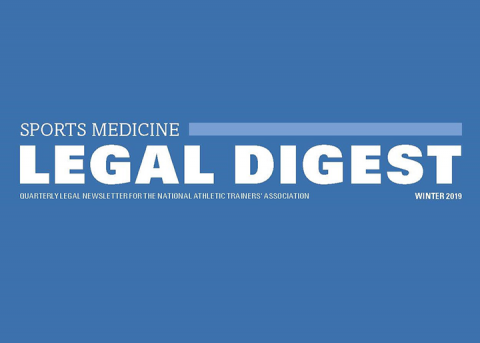
The Winter 2019 edition of the Sports Medicine Legal Digest takes a closer look at the importance of creating a safe environment for employees and patients, how to set workplace boundaries and an AT’s duty to report when they suspect sexual abuse or harassment
The Board of Certification Standards of Professional Practice consists of two sections: practice standards and code of professional responsibility. The latter is vital when working in a workplace where patients come from all different backgrounds.
Scott W. Cheatham, PhD, DPT, ATC, worked with the BOC Ethics Committee and is a legal expert for the PT Board of California and expert consultant. Over the years, he has been an expert witness on various legal case involving ATs and other allied health professionals due to negligence in busy facilities, assaults, consent issues, inappropriate communication and more. Although an organization shouldn’t have so many regulations as to make the workplace impossibly strict, it’s necessary to refresh and remember that there are legal risks ATs face every day that should be present in their minds. Here are some ways in which ATs can work to set appropriate professional boundaries.
- Create an honor code: To make the athletic training facility environment professional, Cheatham said to consider creating an honor code that covers Equal Employment Opportunity Commission topics, such as gender neutral terms and other cultural competency strategies. Topics in the honor code may include but is not limited to: HIPPA and patient privacy, appropriate use of communication with student athletes, and precautionary discussion topics.
- Have annual training: Cheatham also recommends that staff and student athletes complete some type of annual training to remind everyone that a safe environment is needed for all parties. Common training methods include live talks, live webinars and internet-based courses. Upon completion, the participants can sign and date the code of honor acknowledging the completion of the course and full understanding of the policies. The annual training can apply to all levels including high school, collegiate, recreation and professional. Hot topics for annual training may include: cultural competency in AT, gender inclusion and HIPPA regulation reminders.
- Get preapproved consent from parents for minors: In many settings, ATs treat student athletes who are minors. Having the proper permissions in place from the parent and student athlete will help all parties understand their roles in the treatment of the athlete. Prior to preseason screenings, ATs can ask their legal team to draw up a consent form for the parent/s and student athlete to read and sign before the screenings. The form should list treatments that could be conducted on the student athlete during the season. ATs should avoid putting themselves at legal risk by being aware of a patient’s comfort and well-being. A consent form can help ensure parents, patients and the athletic trainer are all on the same page.
- Think about the patient’s comfort during examination or treatment: ATs should avoid putting themselves at legal risk and be mindful of their patient’s comfort. Whether the patient is a minor or an adult, ATs should properly and carefully communicate the proposed examination and/or treatment and obtain verbal consent. Proper draping of patients during the examination and treatment is a must, especially in an open treatment area. If a patient is in a private room, it’s important to obtain further verbal consent and, at times, have someone of the same sex in the room may help the patient to feel comfortable.
- Use your resources: It’s an AT’s responsibility to stay involved in the conversation of creating an ethical and responsible work environment. Doing so means going out of the way to stay current on important topics pertaining to ethics, workplace behavior and more. Make sure to attend webinars, attend ethics trainings, read the Sports Medicine Legal Digest and discuss latest practices with fellow ATs, as well as using and following the NATA Code of Ethics.
- Establish baseline policies and procedures: For a department or organization, the policies and procedures help guide the staff and protect all parties , Cheatham recommends that the policies and procedure be updated whenever changes occur or on an annual basis. All employees should receive a copy of the updates and sign a form that they have received the updates and fully understand. This ensures a universal understanding among all supervisors, medical, and AT staff. It’s common to simply update the policies and procedure manuals for all employees when needed or annually.
- Remember confidential reporting: Every organization should have a confidential pathway for all employees to report an unethical workplace practice. Many states have “whistleblower” laws that protect the reporting employee from retaliatory behavior from fellow employees. The AT must understand the reporting rights in their specific setting. Different states may have laws for both private and public organizations. For example, most, if not all, collegiate settings will fall under Title IX, which has specific reporting guidelines for sexual harassment and other workplace topics. ATs are encouraged to educate themselves on reporting procedures.
- Check your state’s laws: Every state will have different laws pertaining to sexual harassment and mandated reporting, so be sure to familiarize yourself with these legal issues. Cheatham recommends that every AT should have a full understanding of their state AT practice act in order to understand their scope of practice and laws pertaining to these topics discussed. For more information about professional practice, refer to the NATA Code of Ethics, and be sure to check out the latest issue of Sports Medicine Legal Digest for more information regarding setting workplace boundaries.





